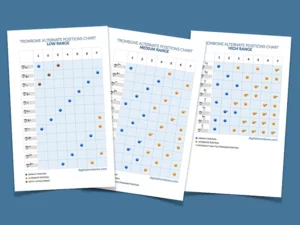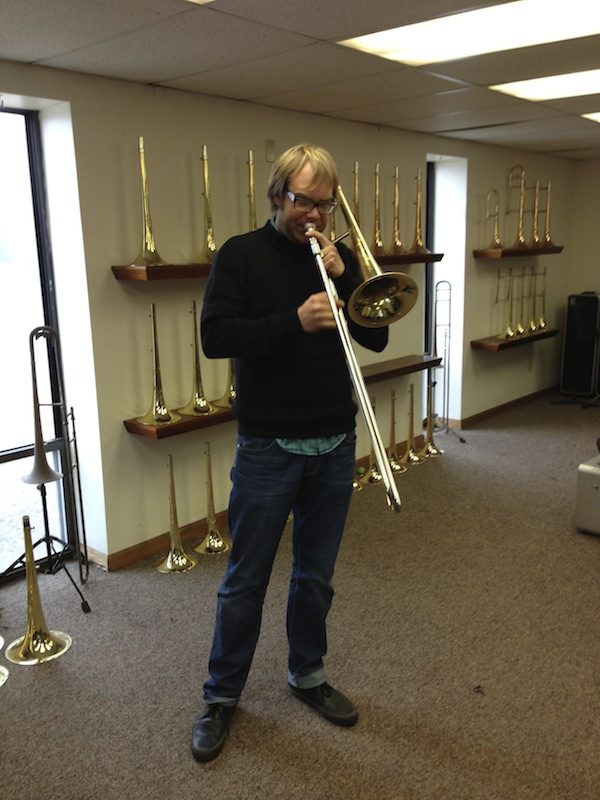
Visiting the Shires factory
During a recent visit to the S.E. Shires factory, I was fortunate enough to experience firsthand the range of trombones they offer. Nestled in the unassuming industrial area of Hopedale, Massachusetts, the factory’s location is conveniently about an hour’s drive from Boston and a four-hour journey from New York. The unassuming exterior of the building belies the fact that it houses a world-class brass instrument manufacturer. Make no mistake, appearances can be deceiving; S.E. Shires is a company dedicated to their craft, possessing an in-depth understanding of every facet of trombone construction and design, from the hows and whys to even the whens. My introduction was facilitated by renowned New York trombone player and Shires artist, Michael Davis, and this gave me the privilege of meeting Steve Shires, along with Ben Griffin, the Shires sales representative and accomplished trombone player. Ben has deep knowledge about trombones of all sizes and was very helpful during my visit. He set me up in the Shires showroom and kept feeding me with new trombone parts for several hours.
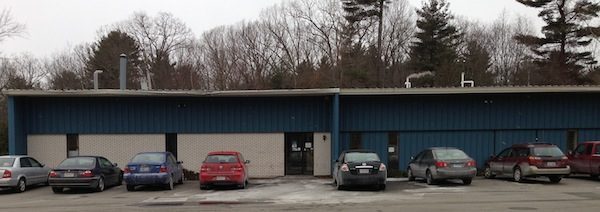
S.E. Shires factory, Hopedale, Massachusetts
Since I knew I would be buying a small bore horn, this was where I started out. Unfortunately, I never got around to trying out their large bore trombones – a compelling incentive for a return visit. In this article, I will review the trombone parts I tried, including the Michael Davis Signature Model. Additionally, I will share the details of the particular choice I ultimately settled on for my dream trombone.
These are all the trombone parts I tried

Slides:
T00NLW My choice
T00LW
T95NLW, YRC (from the Michael Davis model)
Lead pipes:
T0 2N (Nickel with #2 venturi, .500 bore) My choice
T0 2.5 (Brass, #2.5 venturi, .500 bore) My alternative choice
Tuning slides:
SY1.5 My choice
SY1.0
SY
Mouthpiece:
S.E. Shires Vintage 6 1/2 AL
Bells:
S1YLW 8 (Lightweight yellow brass, soldered bead 8″)
S1RGLW 8 (Lightweight, dual alloy, red brass stem, and gold brass flare, soldered bead 8”)
S1YLW 7.75 (Lightweight yellow brass, soldered bead 7.75″) My choice
S1YLM 7.75 (Mediumweight yellow brass, soldered bead, 7.75″)
Michael Davis signature bell (7.5” bell)
See all the Shires small bore trombone options here
Click here to read my full Shires trombone review.
Test: Shires bells
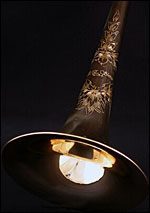
All bells tested were two-piece bells, meaning that they are made of two pieces of metal that are soldered together just before the point where the bell diameter expands drastically. When looking at the trombone on a stand, the soldering is made horizontal. The metal in the two-piece bell gets a bit thicker towards the rim and delivers a clear sound that does not crack easily.
I did not test any one-piece bells during my evaluation. Those bells often exhibit a slight thinning of the metal toward the bell’s terminus. As a result, they tend to exude a touch less stability and offer a subtly mellower tonal quality. Intriguingly, they possess the ability to render a more expansive and open sensation, though occasionally at the expense of surgical precision. Yet, it’s important to clarify that it’s a matter purely governed by personal preference—a distinctive and individual taste.
For my precise needs, however, I was seeking certain traits in a small-bore trombone bell primed for jazz solo performances. Hence, the attributes of a one-piece bell, with its unique sonic signature and dynamic characteristics, did not precisely align with my specific requisites.
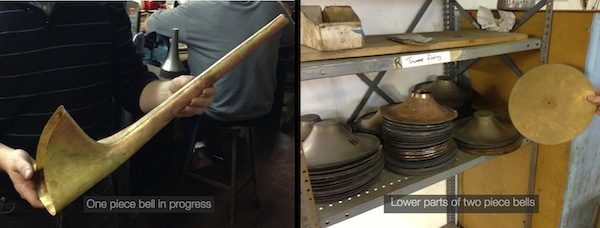
About soldered beads
The bead is the rounded rim on the bell, and a soldered bead indicates that a metal strip runs along the inner rim, securely joined through soldering. This method stands as the most prevalent technique for bell fabrication, imparting heightened stability to the bell itself and consequently facilitating greater control for the player. In contrast, an unsoldered bead signifies that the metal ring encircling the rim remains unattached to the trombone itself. (This scenario might potentially lead to a razzling sound if the build quality falls short.)
An unsoldered bead often yields a more intricate and resonant timbre, albeit at the expense of projection and attack clarity. Notably, older Conn trombones sport unsoldered beads, while Bach and King trombones, as well as newer Conn models, embrace the soldered bead construction.
Shires S1YLW 8
This 8” yellow brass bell offers excellent responsiveness and a comfortable playing experience. It’s an ideal size for 3rd trombone positions in big band or commercial settings. However, I find that for small group jazz gigs, a smaller bell works better for me, as it delivers a more fitting performance. While this bell responds exceptionally well across all registers, it lacks the light, bouncy quality of the 7.75” bells when playing jazz solos.
Shires S1RGLW 8
Very similar to the S1YLW 8 bell, but this one is gold brass. It is a bit darker and more “serious” than its yellow brass sister, making it a great bell for light orchestral playing or church gigs. I wouldn´t mind having a 8” bell at my shelf at home as well as a smaller one, but the choice between yellow brass and gold brass is a bit tricky. I would personally go for the gold brass, just to make the leap from my smaller bell a bit larger.
Shires S1YLW 7.75
I ended up purchasing this bell – in my opinion a fantastic choice for jazz performances, thanks to its remarkable responsiveness and the way it delivers an open, clear, and projecting sound. During my experimentation, I tested it both with and without the counterweight, ultimately deciding to keep it on. This addition adds a touch of tightness to the whole setup, amplifying my control even further. When the counterweight is off, the horn feels slightly softer and less focused. Placing it on the lower bar creates a result somewhere in between having the counterweight on or off. All three options hold their own value, and I might find myself alternating between them to keep things fresh and varied.
Shires S1YLM 7.75
This is also a nice bell, but not my first choice. It carries a slightly mellower tone and doesn’t quite capture the same bounciness that I admired in the lighter S1YLW 7.75 bell.
Michael Davis’s signature trombone
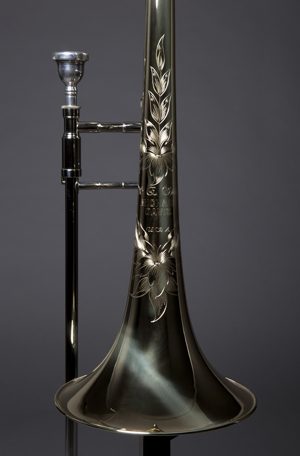
This horn truly stands out, boasting an impressive level of responsiveness that caught my attention. When it comes to size, it aligns rather nicely with the King 2B I had been accustomed to playing. However, I couldn’t help but notice a slight sense of narrowness, which left me yearning for a tad more room to maneuver. Despite its smaller bell size, there’s a surprising depth to its sound – a subtle darkness that I attribute to the bell’s lightweight construction. In my view, this horn holds significant appeal for a specific group of players: those who favor compact horns and possess a measured approach to their playing, underlining the importance of a solid breathing technique.
When dealing with narrower tubing, a heightened sense of precision in managing airflow becomes paramount. On the flip side, larger tubes and those generous large bore trombones tend to be a touch more lenient (though, let’s be clear, maintaining a strong breathing technique is vital regardless of trombone size!). My exploration led me to pair the Michael Davis Signature bell with the slightly more capacious T00NLW slide, although this union wasn’t without its quirks. It’s evident that this bell yearns for the Michael Davis slide. Also, the folks at Shires have made it clear they’re keeping these parts bundled.
Now, let’s talk about the handlebar on the Michael Davis slide – it’s sleek and slender. This design choice is downright delightful, lending it a sensation akin to the nimble grace of a sports car. It felt so good in my hands that I found myself wishing for this handlebar upgrade across all my slides. It’s a small detail that makes a noticeable difference – just like that sporty spoiler on a race car!
Michael Davis told me that he is so pleased with this trombone that he bid farewell to both his trusty King 2B and 3B. Try it out – it might very well be your dream horn! I found this trombone to be clearly superior to my otherwise beloved King 2B (anniversary model with silver bell, a copy of their own legendary Silversonic from the sixties), but I also found out that my way of playing was better supported by a slightly bigger horn, and I therefor ended up with a .500 bore slide and 7 3/4” bell. The Michael Davis model has a .495 bore and 7,5” bell.
Shires trombone slide: lightweight or not?
I once tried a lightweight slide on my King 2B, and I found it to be a poor solution with a weaker, less defined sound and attack. That made me believe that lightweight is just not the way to go unless you have crazy weak arms or never play louder than a whisper in space.
It’s worth noting that Shires’ lightweight offerings don’t quite match the featherweight feel you might find in comparable low-fat trombone parts from other manufacturers. So, if you’re all about that grand, robust sound, don’t let the “lightweight” label scare you off. Yet, as with any musical adventure, the proof is in the playing. It’s a journey of personal taste and playing style, where the best choice is more about discovering what resonates with your artistic expression rather than adhering to a one-size-fits-all approach.
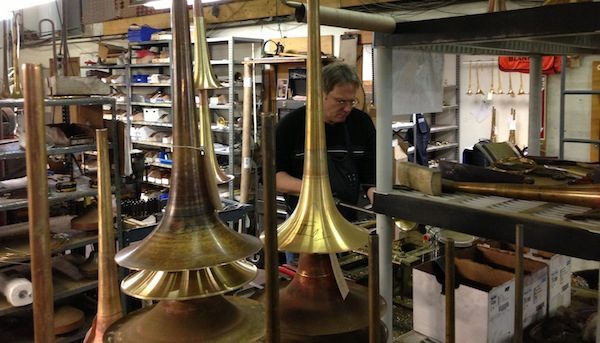
Steve Shires spinning bells in the factory
Test: Shires tuning slides:
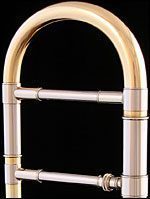 SY1.5 – my choice
SY1.5 – my choice
SY1.0
SY (standard)
I was genuinely surprised by how significantly different tuning slides can alter the trombone’s feel! After a thorough exploration, I eventually settled on the SY1.5 tuning slide, which is a tad more petite compared to the standard SY. This choice rewarded me with a finely focused sound coupled with swift responsiveness – precisely the attributes that my new horn needed to possess.
Oddly enough, the standard SY tuning slide failed to hit the mark for me. Instead of enhancing the experience, it almost transformed my small-bore trombone into a large-bore counterpart! Great match for someone who mainly plays large-bore trombones?
Nestled comfortably in between these two contrasting options, the SY1.0 strikes a balance. It boasts a slight edge in size over the SY1.5 while still remaining a smidge smaller than the standard SY tuning slide.
Luckily I did not have the chance to try all available tuning slide models, or I would probably still be in the showroom trying different trombone configurations…
Test: Shires mouthpiece
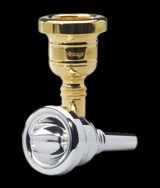 S.E. Shires Vintage 6 1/2 AL mouthpiece
S.E. Shires Vintage 6 1/2 AL mouthpiece
My first impression of this mouthpiece is that it is really well-designed. Its tactile response is superb, accompanied by a rich, resonant sound characterized by an abundance of harmonics. The only reason I didn’t adopt it as my own is that I’ve grown quite content with the flatter rim featured on my Dennis Wick 7CS mouthpiece (Note: The 7CS has since been replaced with the fantastic Laskey 50C mouthpiece). Had I still been playing my former Schilke 51B, I would have readily transitioned to the Shires 6 1/2 AL mouthpiece without hesitation.
Discovering the perfect trombone mouthpiece is undeniably subjective, and there are no definite right or wrong opinions. My brief interaction with the Shires mouthpiece did, however, unveil a meticulously crafted product. Therefore, if they happen to offer a mouthpiece with similar dimensions, rim contour, and cup size as your current choice, I wholeheartedly recommend exploring their offerings.
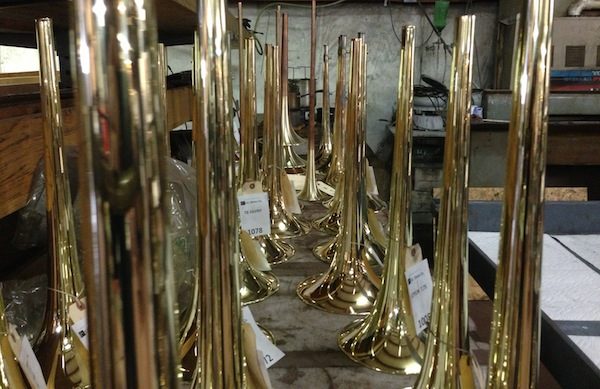
Forrest of bells
Shires general trombone design
Shires trombones bear a striking resemblance to, well, your quintessential trombone. Their design follows the classic WYSIWYG principle – what you see is precisely what you get. And let’s be honest, there’s nothing inherently wrong with this approach. However, I can’t help but feel that they possess untapped potential when it comes to instrument design. Craftsmanship of this caliber surely deserves a distinctive aesthetic. It’s an opportunity to let them stand out, to give them a visual persona that matches their outstanding performance. Imagine these horns on stage, not just delivering superb music, but also visually capturing attention and becoming instantly recognizable.
Is this a missed opportunity, or do Steve Shires’ trombone designs simply mirror his philosophy of crafting no-nonsense, top-of-the-line instruments with an unwavering emphasis on exceptional performance?

My Shires trombone
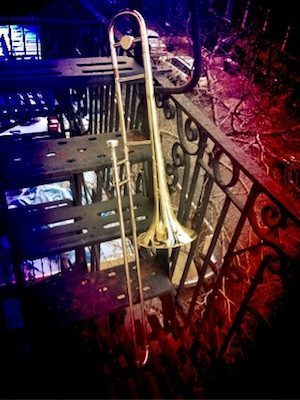 I visited the Shires factory with the firm knowledge that they craft some of the finest trombones available. Without a shred of doubt, I knew I would depart with an exceptional new instrument in hand. Trying out the different models and getting to feel how big a difference small design changes do to the trombone was a great experience.
I visited the Shires factory with the firm knowledge that they craft some of the finest trombones available. Without a shred of doubt, I knew I would depart with an exceptional new instrument in hand. Trying out the different models and getting to feel how big a difference small design changes do to the trombone was a great experience.
My objective was to find a horn with great response and precision. A good sound is also important, but luckily I tend to like the sound of a trombone if I like the feel of the instrument – and most trombones will soon end up sounding like you anyway. In my opinion, it is easier to find a good sound on a trombone that is easy to play, rather than vice versa.
I ended up with the following Shires small bore trombone configuration:
Bell: S1YLW lightweight yellow brass 7.75” bell,
Slide: T00NLW lightweight .500 bore slide with nickel tubing
Lead pipe: T0 2N nickel with #2 venturi
Tuning slide: SY1.5
All of this paired with a Laskey 50C mouthpiece.
httpv://youtu.be/FgWMDm-eK-Y
This is by far the best trombone I have ever played! It has a unique response, great precision, and a full, rich sound. The horn can play incredibly loud without cracking (as a matter of fact, I can’t really get it to crack…). The tone is not as sparkling as my old silver 2B, but this does not feel like a sacrifice. It has a more modern sound, and I actually prefer this. The horn really improves my playing. Whatever I throw at it, it turns into music. This trombone gives me more confidence and I feel much more relaxed while playing than before.
The high A flat is usually a problematic tone on a trombone. It can be harder to hit than the surrounding notes and the sound is often a bit muffled. But not on my new horn – this little detail tells me a lot about the general quality of Steve Shires’ instruments!
Do I recommend Shires trombones? YES!
But – they have soooo many options, that you will need a pretty big selection of parts at hand in order to find the perfect match for you.
“Standard” and vintage trombones vs. custom trombones
Many of the old go-to professional horns (like Bach, King, Conn, etc.) offer an excellent sound and a satisfying playing experience. However, my transition to custom or high-quality small trombone manufacturers elicited a feeling akin to moving from a Ford Mondeo to a luxurious Mercedes. The Mondeo is undeniably exceptional, effortlessly fulfilling all the necessary aspects of a car – roomy, powerful, and comfortable. At first glance, it might seem impossible for anything to be significantly better. But then you get into the luxury Mercedes, and realize that everything could be improved, and by quite a lot!
That´s how I feel about custom trombones such as Shires, Schmelzer, Rath, and others. They add something to the feel and comfort of playing that I have not found in the “standard” horns. I like that. I have had the opportunity to try several of the smaller luxury brands on the same occasion, and for me, Shires was clearly a better fit than the rest of the bunch. But that´s my personal opinion.
Sound
I think some of the older vintage horns can have a more interesting sound with more personality than than the new Mercedes-bones. But honestly, I don’t care! I believe that any instrument (especially a good one) will sound like me eventually, and whatever I might lose (but not necessarily miss) in the sound, I will live happily without it. Modern trombones tend to have a more composed and focused sound, and most of the time, I prefer working with that.
Good luck with your trombone hunting!
Coming up: exclusive interview with Steve Shires and report from the factory floor.
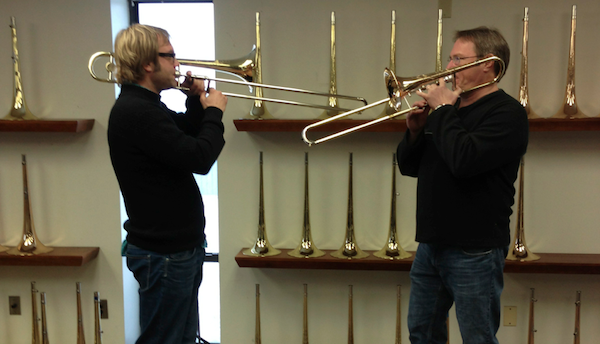
Anders Larson & Steve Shires, founder of Shires
10 Comments
-
Hej, Anders. Jeg er utrolig glad for din artikel. Jeg undersøger netop mulighederne for at prøve Shires. Jeg har kontaktet Steve for evt. at besøge stedet; men vil i første omgang forsøge at prøve instrumentet i Freiburg. De har imidlertid ikke fået instrumentet til Tyskland endnu. Jeg tænker på Michael Davis udgaven. Men dejligt at høre, det er den kvalitet, jeg søger efter.
All the best.
Jens -
Question:
If you were to be totally scientific.
Please describe your horn or horns you regularly used before visiting the Shires Factory and what makes your new Shires horn great…
I have heard great things about Shires horns, but some aspects of trombones are in my opinion a placebo…
Most trombone players (me included) have a box of mouthpieces and a few different horns all on a quest for a magic bullet…
What tests did you execute when testing your Shires setup?
Why did you choose one part over another?
Lead pipe choice?
Tuning slide Choice?
Bell choice?Thank you for sharing this information
-
Looks like I spoke too soon. I saw your other pages after my first post.
In addition, I believe you are right in your assessment of missed opportunity of Shires.
It is very possible that Steve Shires makes the best Trombones in the world, but I don’t believe there is any great marketing/selling being done to make them a household name…
Perhaps, Steve is comfortable with it the way it is and he has enough work to keep his staff working, but IMHO we as trombone players are very bad about perception. As an example, as soon as the other guys, Getzen/Edwards announced their new Joe Alessi model a bunch guys went out and bought it. (We all know that Steve Shires made the first modular trombone for Getzen etc, but that is old history now…) However, I see two of them being sold on trombone.org classifieds. The truth is that a great player will sound good on anything…
Thank you for giving us digital Trombone!
-
Hi Pablito!
Thanks for your comments! I would like to specify my view on custom / high quality small trombone manufacturers versus “standard” instruments as well as old vintage horns:
Many old and standard pro horns (Bach, King, Conn etc.) have a great sound and feel very nice to play. But my experience when switching to the custom / high quality small trombone manufacturers is somewhat the same as going from a Ford Mondeo to a luxury line Mercedes. The Mondeo is great and does everything you a car to do with ease, with plenty of space, power and comfort. How could it possibly be much better? But then you get into the luxury Merc, and realize that everything could be improved, and by quite a lot!
That´s how I feel about custom trombones such as Shires, Schmelzer, Rath and others like them. They add something to the feel and comfort of playing that I have not found in the “standard” horns. I like that. I have the opportunity to try several of the smaller luxury brands at the same occasion, and for me Shires was clearly a better fit than the rest of the bunch. But that´s my personal opinion.
SOUND: I think some of the older vintage horns can have a more interesting sound than the new Mercedes-bones. Lighter and with more personality. But honestly, I don´t care! I believe that any instrument (especially a good one) will sound like me eventually, and whatever I might loose (but not necessary miss) in the sound, I will live happily without.
All the best,
Anders(this comment is added to the end of the article as well)
-
Jens, thanks for your comment! You should check out in advance if the music store you are visiting actually have any small bore horns available (Shires sell and produce mostly large bore horns), as well as what options they have available. Good luck with it!
Anders
-
Great article Anders!
Back in 2005, on a visit to NY from Melbourne, I also went to the factory, with my Bach 12 bell and a Bach 16 Mt Vernon slide – (I wore out my old 12 lightweight slide. The 16 slide was also showing the first signs of wearing out – brass showing thru the nickel plate in spots). The first question I was asked was:
“Why are you here? That’s a good horn. What else could you want?” – and after …25 years playing that horn in both its versions, I had never played any horn I had liked better – until then. Suddenly, my beloved Bach felt like cardboard!
All your comments about the differences between the new and old horns match my experience. In the factory, all I was concerned with was the sound – the feel of the horns was perfect, and the blowing more consistent than anything I’d tried before.
I bought my Shires in Melbourne 3 years after that visit, having saved the specs of the horn I’d put together in the factory, and I love it!
I started out trying to build a better version of the same horn, but found qualities in the search that I really liked. Each component changes so many things! Tone colour, whether the sound is out front or all around you…
One thing though if you haven’t already picked out your parts: Really check out the balance of the horn’s intonation when you’re selecting your components… I got the standard SY tuning slide and have had to work hard to get used to a couple of intonation issues – the D harmonic was sharp and needed flattening, contrary to 25 years of sharpening on the Bach! – I had never heard about the 1.5 tuning slide that corrects those things on my horn. I’ve now tried and tested one, and it works well but I haven’t got one yet. I probably will do – it’ll smooth the swapping from large to small bore horns for me.
I stayed off my Bach for 3 years to really zone in on my Shires – mainly for tuning, and then went back for a play recently and I found so much that I love about it – things missing from the Shires – but on balance, the Shires is still by far the better horn for all the small bore playing I do, and I can’t recommend them highly enough.
Dave -
Dave, thanks for your input! I too have to watch out with the D# on my Shires since it is too high. I believe this is one of the default problem notes with trombones in general. Is it more obvious on Shires? I don´t think so, had to adjust on my King as well. Maybe your Bach is more in tune than most trombones on this note?
While being on third position – I love the response on the high Ab. This is usually a note that feels numb on many trombones, but on my new horn there is absolutely no difference in sound and feel between the Ab and the surrounding A and G!
Still in love 🙂
-
Thank you for your review. I am a returning trombone player, and wish to focus on jazz. I grew up playing a Bach 42B, and have been researching small bore horns. Shires has definitely been on my RADAR.
I spoke with Ben at Shires and he suggested a set up similar to yours: LW1 Bell, Nickel .500 slide, but a 1.0 tuning slide.
Questions:
1. Do you still REALLY like your horn?
2. What is the difference in a 1.0 vs. 1.5 tuning slide?
3. How do Shires compare to Rath in small bore jazz horns?Thanks,
DH -
Dave, great comment and thanks for the input! I would think that coming from a Bach could make the leap to Shires a bit smaller. I have always admired Bach trombones for their precision, but their small bore horns never caught my heart.
Going from a silver King, I lost some brilliance and liveliness in the sound, but I love the full, rich sound on the Shires. And since I tend to take quite a lot of chances while playing, it suits me fine with a horn that is actually trying to save my …! That Silversonic is one moody horn…but fantastic when the chops are great.
Also have to get used to intonation, especially Eb on third is a bit further out than I am used to.
Cheers,
Anders -
Hi, ive been playing student Yamaha Bb tenor for 30 years, the slide is worn and pitted. I want to geta pro horn but have no idea what or how much i should spend. £2000, Seems a lot as im not a pro, but i do play every weekend in funk,soul or ska bands. Other players say i have a great sound so should put up with slide problems. I have the silver bell which is £3000 on a pro horn. Any advice?? Thanks Trevor


